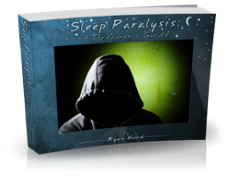
| Connect & Subscribe |
What Types Of Dreams Do You Have?
Written by Joel Aguero with contributions from Kevin Morton, Winter 2010"Dreams are real while they last. Can we say more of life?"
-Havelock Ellis
The above quote, from the unorthodox writer Havelock Ellis, is among Dr. Dement's all-time favorites. And for good reason. Can we say more of life? How profound an insight into the nature of what a dream actually is.
But in understanding what a dream is, we must take into account the different types of dreams, from the seemingly inexplicable to the types of dreams that we actually can exercise control over.
Dreaming can be an extraordinarily far-reaching and unwieldy topic. There's so much we don't know for sure about the subject, and so many facets that only educated speculation has been able to penetrate. With this in mind, and in order to focus our discussion of dreams, we will begin by categorizing dreams into three different general types: normal dreams, lucid dreams, and nightmares.
Normal Dreams
Normal dreams constitute the most common type of dreaming. They are dreams in which the dreamer is unaware that what he is experiencing is a fabricated reality: a dream in which the dreamer's brain does not distinguish between the dream world and the real world.

In normal dreams, the dreamer experiences a sequence of events as an alternative reality (but one that feels quite real during the dream) and possesses no real control over the content of the dream. Additionally, events that would normally be recognized as improbable are typically not scrutinized in a normal dream due in part to the fact that the dream is perceived by the dreamer as real.
With this said, it is interesting to note that the phrase "normal dreams" is a bit of an oxymoron in almost any case. Dreams themselves are often very strange, and while they are normal in the sense that everyone experiences them, they are certainly not "normal" in their content much of the time.
Lucid Dreams
Contrary to normal dreams, lucid dreams are dreams in which the dreamer is aware that he or she is, in fact, dreaming. Skilled lucid dreamers can take advantage of this realization to actually take control of their dreams. Woah, what?! Find out more about lucid dreaming and the possibilities it holds.
 Once a lucid dreamer becomes aware that she is in the dream world, she can often take control of the dream and do whatever she pleases.
Once a lucid dreamer becomes aware that she is in the dream world, she can often take control of the dream and do whatever she pleases.
Lucid dreaming denotes more complex conscious thought when compared to typical dreaming, which seems likely to contribute to the vivid quality described by lucid dreamers. Normal dreams can be quite vivid themselves, especially while they are taking place, but the imperfection of dream recall in the waking state substantially limits this vivacity for any extended period of time.
As Dr. Dement likes to say, "We see our dreams through the frosted glass of memory."
Lucid dreams, on the other hand, allow the dreamer to partially defrost this glass to a significant extent. In fact, some lucid dreamers go as far as to say that upon awakening they are left with a memory of the dream that is comparable to an event in experienced in the state of wakefulness.
Think this sounds amazing? Well, the most amazing part is that people can learn to lucid dream. You can train yourself. Find out more about lucid dreaming here.
Nightmares
 What is a nightmare? When we really think about it, that question is a lot more loaded than it maybe first appears. When asking himself that same question, our artist Andrew Hines came up with the above response.
What is a nightmare? When we really think about it, that question is a lot more loaded than it maybe first appears. When asking himself that same question, our artist Andrew Hines came up with the above response.
The final type of dream, nightmares, is comparable to normal dreams with one distinguishing difference. Nightmares are accompanied by intense anxiety, fear, or paranoia and are generally recognized as extremely unpleasant by the dreamer.
They often include events that would evoke a high amount of stimulation if one were to experience them regularly, which may contribute to the act of waking up from a bad nightmare. Upon waking from a nightmare, one typically experiences intense feelings of relief.
About This Site
Welcome! This site is continuously being created by students of Dr. William C. Dement's Sleep And Dreams course at Stanford University.
We made this site as a call to action for people all over the world to live healthier, happier, safer, and more productive lives by learning about their own sleep. We have faith that reading the information provided on this site will motivate you to be smart about your sleep deprivation and strategic about your alertness in order to live life to your fullest, most energetic potential.
In fact, we challenge you to do so! What do you say, are you up for the challenge?
Interviews With Sleep Specialists: Insights Into the Worlds of Sleep Medicine & Sleep Business
America's Most Dangerous Disorder: What Is Sleep Apnea Doing To Your Sleep?
Sleep Debt: How Much More Will You Achieve When You Reduce Yours?
The Stages Of Sleep: The Journey Through The Night
Delayed Sleep Phase: You Want To Sleep But You're Not Tired Yet
Paralyzed at Night: Is Sleep Paralysis Normal?
Sleep In Words: Smart, Strange, and Funny Quotes About Sleep
Sleep Disorders In Children: What's Keeping Your Child From A Full Night's Rest?
Attacks of Pavor Nocturnus (a.k.a. Sleep Terrors, Night Terrors, or Incubus Attacks)
The Stanford Sleep Book
Dr. Dement's pioneering textbook has been the core text for Sleep and Dreams since 1980, but it has just recently been made available to the wider public for the first time.
In it you'll find a more detailed account of the most important things you need to know about sleep, alertness, dreams, and sleep disorders. Studies, statistics, plus plenty of Dr. Dement's classic anecdotes painting the history of sleep medicine.
Preface | Intro | Contents | Get A Copy
More Sleep Resources
The Zeo
A revolution in personal sleep tracking, the Zeo is a wireless headband that transmits your brainwaves in realtime to a dock (pictured here) or your smartphone. The result? You can wake up and see exactly what stages of sleep you were in during the night! Unprecedented personalized sleep knowledge.
Sleep Paralysis: A Dreamer's Guide
Ever woken up paralyzed? A surprising number of us have, believe it or not. But few know the actual causes of this phenomenon, and fewer still how to exert control over it. Dream researcher and sleep paralysis expert Ryan Hurd shares breakthrough insights into how to do just that.
Important Disclaimer
Please Note:
The information found on this page and throughout this site is intended for general information purposes only. While it may prove useful and empowering, it is NOT intended as a substitute for the expertise and judgments of healthcare practitioners.
For more info, see our
Terms of Use.









